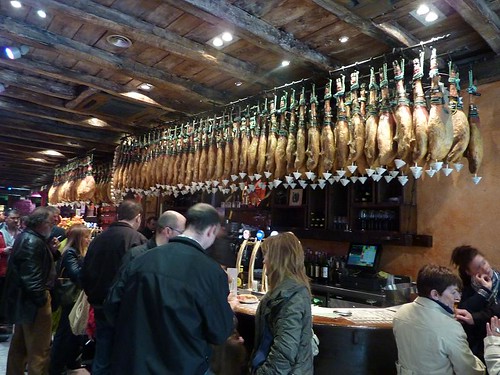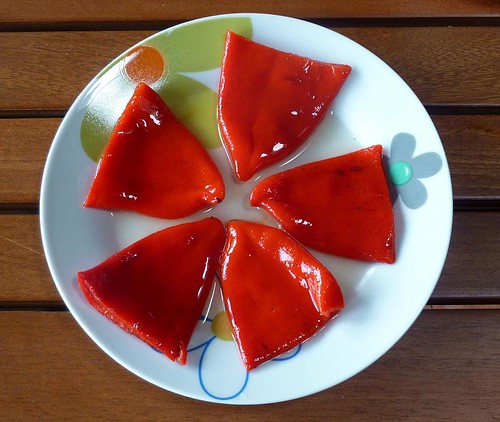After almost two months in Spain, I think I’m beginning to understand what Spanish food is all about. Our initial impressions were not good. With one honourable exception, restaurant cooking here seems to be bland, stodgy, and unadventurous. And revolves around meat. Lots of it (not so surprising given that it’s a livestock-raising area). The menus at all the local restaurants have many, many things in common: ensalada mixta, ensalada russa, arroz con leche, flan, natillas, and cuajada (sheep’s-milk junket) feature on all of them. Main courses are usually massive platefuls of roast or grilled meat. Low points were the albondigas (meat balls) served in thick, Bisto-flavoured gravy, and bechamel-coated deep-fried lamb chops. There seems to be little concern with freshness and flavour.
Meanwhile, shops and supermarkets in our local small town were poorly stocked and uninspiring. The spice rack in the supermarket was a particularly sorry sight. Black pepper. Two kinds of pimentón (dulce and picante). Cinnamon (sticks and ground). Nutmeg. Herbes de Provence. Yellow food colouring (cheaper than saffron). Lots and lots of packets of “paella spice”, of which a major ingredient is the aforesaid colouring. “But where’s the ginger? And what about cumin? Or coriander?” Nowhere to be seen – I ended up bringing some back from France.
But then we hit the covered market in Irún. Revelation! Of course, living in France we are used to markets, even blasé about them. Superficially a Spanish market looks much like a French one, but this was different enough that we wandered spellbound around the stalls, oohing and aahing over the produce, and left laden with a week’s supply of food.
First, the preserved food stall. Bottled and tinned food is considered a worthy genre in its own right in Spain, and this is not surprising when you consider: thick chunks of bonito del norte (tuna) in brine, nothing like the flaky scraps in tins; whole, roasted piquillo peppers in oil, lusciously juicy and ready to eat straight from the jar; olives, of course, in their many forms; anchovies and boquerones; cans and bottles of olive oil. Half a dozen varieties of dried beans, dried fruit and nuts are piled in bins. And of course, since this is the Basque country, strings of dried peppers hang from the ceiling.
Then the preserved meat stall. The stallholder sharpens his menacing-looking knives, ready to serve you. Jamón, of course, in multiple varieties, ranging from garnet-red to purple, edged with frills of white fat, at prices ranging from maybe 10 euros a kilo for standard serrano ham to an astonishing 80 for the best bellota. The extra you pay for jamón ibérico is worth it, for bellota I can’t yet say. Multiple varieties of salami, sausage, and lomo ahumado are also on offer. The most notable sight at the butcher next door is tiny legs of lamb, weighing barely a kilo each; it seems Spaniards are fond of milk-fed lamb. We bought one of these, marinated it briefly in a paste of olives, capers, anchovies, olive oil, and pimentón, grilled it on the barbecue, and ate the whole thing between the two of us.
The cheese stalls might not rival French ones (OK, they definitely don’t). But there are a few varieties of hard cheese, from Manchego to Ossau-Iraty, dozens of local sheep’s cheeses, and bags of raw sheep’s milk (I snapped up one of these to make my own cuajada).
Then whole stalls are devoted to that Basque staple, bacalao, again with major divergences in price, from thin, scrappy pieces stiff as a board with salt, to thick chunks of boneless cod steak at 25 euros a kilo, waiting for a long soak to be reconstituted as white, flaky fish, gorgeous when simply cooked and served with a lively salsa verde or tomato and pepper sauce. Next door, the fish stalls were piled with glossy fresh fish, with ugly but delicious hake (merluza) playing a starring role alongside beautiful sea bass (lubina), red mullet (salmonete), crabs, lobsters, langoustines, squid, and octopus.
The major “aha” from all this is that Spanish markets lend themselves to simple food that can be nibbled with drinks – that would be tapas then (or pintxos, since we are in the Basque country). Getting home, we simply laid out platters of ham, piquillo peppers, thinly sliced cheese, olives, nuts, cut some bread, opened a bottle of wine, and a lifestyle was born. If you feel the need of something sweet afterwards, a little clay pot of cuajada drizzled with mountain honey hits the spot. Or the Spanish version of lemon sherbet: buy some lemon sorbet and a bottle of cava, combine in a blender, pour into champagne flutes, serve with straws. Who needs to cook?


Sounds so amazing! WOW!
WHAt is hanging above the bar in that first picture???? LOL
Air-dried hams 🙂 Looking at them the other night we calculated that there must be several thousand euros’ worth …
Interesting to hear about the differences between rural France and rural Spain and makes me want to head back to Spain to experience the countryside, something I’ve never done.
It’s fascinating! But it has to be said that the Basque country is particularly special.
Was immediately taken with the idea of lemon sorbet mixed with Cava, or I would use the cremente we get here, I love popping down into Spain.
Hi Sally
It is totally gorgeous on a hot day, an excellent discovery!
You will understand then, why one of my favourite blogs, written by an Australian living in the Basque country, is subtitled “The land of no spice” (http://landofnospice.blogspot.com/).
Thanks for commenting over at mine.
LOL, that’s brilliant Pueblo Girl! Thanks for pointing me to it; the Basque country is a fascinating place, and the more I see of it the more I want to know about it. Back to the land of haute cuisine in just one week …